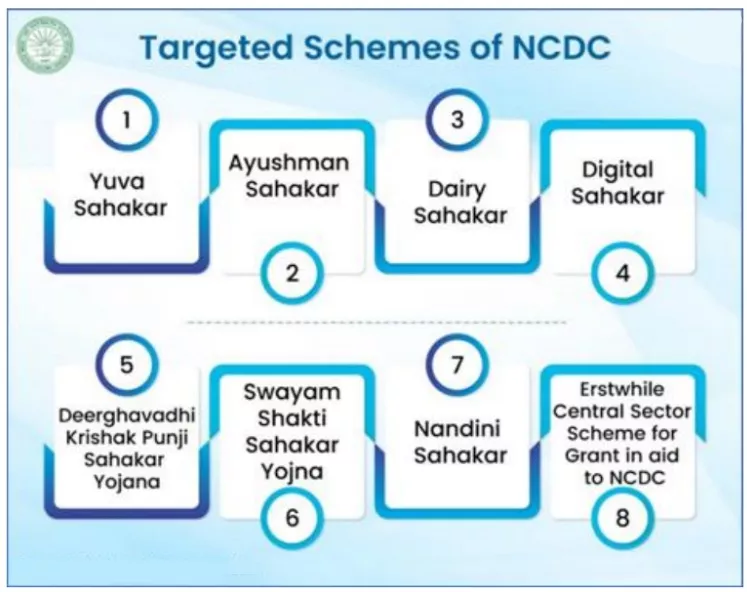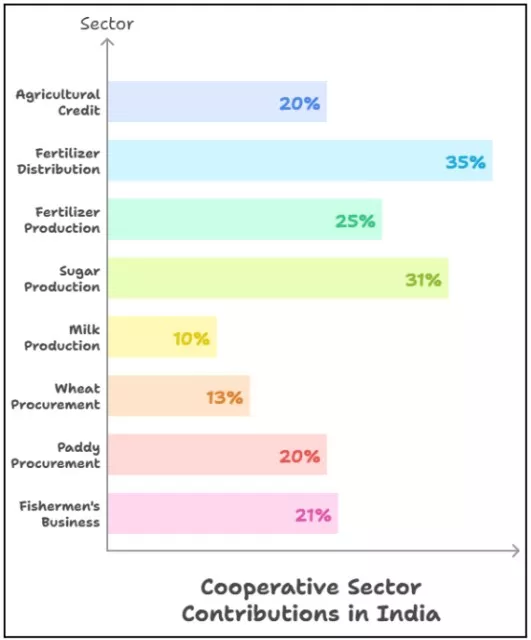The National Cooperative Development Corporation (NCDC) has recorded phenomenal growth over the past decade, with its disbursement soaring nearly 17 times.
Amul – Gujarat Cooperative Milk Marketing Federation (GCMMF)
- Founded: 1946 as Kaira District Cooperative Milk Producers’ Union Ltd. in Anand, Gujarat, by Tribhuvandas Patel, with guidance from Sardar Vallabhbhai Patel and Morarji Desai.
- Brand Launch: “Amul” introduced in 1950; now India’s largest food product brand.
- Structure: 3-tier cooperative model – Village societies → District unions → State federation (GCMMF).
- Impact: Spearheaded India’s White Revolution, ensuring fair returns to farmers and affordable dairy for consumers.
IFFCO – Indian Farmers Fertiliser Cooperative Limited
- Established: 1967, headquarters New Delhi.
- Nature: World’s largest fertiliser cooperative; manufactures and markets urea, DAP, NPK, and Nano Urea.
- Membership: Around 35,000–36,000 cooperative societies, serving 50 million+ farmers.
- Innovation: Pioneered Nano Fertiliser technology, digital platforms like IFFCO Kisan App, and green energy initiatives.
- Governance: Operates on a no-dividend, reinvestment model, funding rural welfare and sustainability projects.
|
- In a landmark achievement for India’s cooperative sector, two of India’s leading cooperatives, Amul and IFFCO, have secured the first and second ranks in the global ranking for cooperatives.
- Event: International Cooperative Alliance (ICA) World Cooperative Monitor 2025 announced at ICA CM50 Conference, Doha, Qatar.
- Scale: ICA report covered the world’s Top 300 cooperatives, with a combined turnover of USD 2.79 trillion (2023).
- By turnover relative to GDP per capita, India’s Amul and IFFCO top the global list, highlighting the strength of cooperatives in emerging economies.
About National Cooperative Development Corporation (NCDC)
- It is a statutory body that promotes and finances cooperative development in agriculture, rural industries, and allied sectors.
- It serves as the apex financial institution for India’s cooperative movement, supporting both farm and non-farm activities through loans, grants, and technical assistance.
- Established in: Set up in 1963 under an National Cooperative Development Corporation Act, 1962.
- Functions Under: Ministry of Cooperation, Government of India.
- Headquarters: Located in New Delhi
- Objective:
- To promote self-reliant, sustainable, and inclusive cooperatives in agriculture and rural industries.
- To enable cooperatives to access long-term credit, working capital, and modern infrastructure.
- To empower marginalized groups, including women and SC/ST cooperatives, through financial inclusion.
- Core Functions: NCDC provides financial assistance in the form of loans and grants to State Governments, State-level cooperative federations, and directly to eligible cooperative societies. Its major activities cover:
- Agriculture And Allied Sectors: crop production, dairy, fisheries, livestock, horticulture, and sericulture.
- Rural Industries: handloom, handicrafts, food processing, and cold chain infrastructure.
- Infrastructure Creation: storage, irrigation, marketing yards, and sanitation.
- Social Inclusion: supporting women cooperatives, SC/ST cooperatives, and youth-led cooperatives.
- Policy Support And Innovation: implementing specialized schemes like Yuva Sahakar, Dairy Sahakar, Ayushman Sahakar, and Digital Sahakar.
- Recent Achievements
- In FY 2024–25, NCDC disbursed ₹95,182.88 crore, a massive jump from ₹5,735.51 crore in 2014–15.
- As of October 2025, disbursement for FY 2025–26 had already reached ₹49,799.06 crore, reflecting continued growth.
- Between FY 2021–22 and 2024–25, NCDC provided ₹4,823.68 crore to women cooperatives and ₹57.78 crore to SC/ST cooperatives.
About Cooperative Societies
- Cooperative societies are voluntary associations of individuals who join together to meet their common economic, social, and cultural needs and aspirations.
- They operate on the principle of mutual help and self-help, prioritising the well-being of their members over profit maximisation.
- Status of Cooperative Societies In India:
-
- Currently there are more than 8 lakh cooperative societies registered in various fields like Housing, Dairy, Agriculture, Finance, etc.
- In 2021, the Ministry of Cooperation was created by the Government of India for realising the vision of ‘Sahkar se Samriddhi’.
- Jurisdiction: Cooperatives are a state subject under the Constitution.
- The subject ‘Cooperative Societies’ is mentioned in entry 32 of the State List under the Seventh Schedule of the Constitution.
Status of Cooperatives in India
- Current Numbers: India has 8.3 lakh cooperative societies.
- Diverse Activities: Over 4,000 PACS approved to open PM Jan Aushadhi Kendras.
- Other Cooperatives are involved in fuel retail, LPG distribution, and rural water and solar schemes.
Constitutional Provisions for Cooperatives in India
- 97th Constitutional Amendment : Added Part IXB (The Co-Operative Societies) to the Constitution.
- The Right to Form Cooperative Societies was included as the Right to Freedom under Article 19 (1).
- Article 43-B that deals with Promotion of Cooperative Societies was also inserted as one of the Directive Principles of State Policy.
- Multi-State Co-operative Societies (Amendment) Act, 2023: Amendment has been brought in the MSCS Act, 2002 to strengthen governance, enhance transparency, increase accountability, reform electoral process and incorporate provisions of 97th Constitutional Amendment in the Multi State Cooperative Societies.
|
Targeted Schemes By NCDC To Strengthen The Cooperative Sector
Below are some of the major schemes of NCDC and how they target different segments of cooperatives:
1. Yuva Sahakar – Cooperative Enterprise Support & Innovation Scheme
- Launched in FY 2019-20, to promote young entrepreneur cooperatives with innovative ideas.
- Eligibility: New cooperatives, Positive net worth, No cash loss etc.
- Since inception: 32 societies sanctioned ~₹49.35 crore, released ~₹3.71 crore. (Limited uptake so far)
2. Ayushman Sahakar
- Launched in: FY 2020-21
- It adopts a holistic approach to strengthening the healthcare ecosystem through cooperative institutions.
- It aims to assist cooperative societies:
- To provide affordable and holistic healthcare through hospitals/ healthcare/ education facilities by cooperative societies,
- To promote AYUSH facilities by cooperative societies,
- To meet the objectives of the National Health Policy,
- To participate in the National Digital Health Mission,
- To provide comprehensive healthcare including education, services, insurance, and activities related thereto.
- Eligibility: Any Cooperative Society registered under any State/Multi-State Cooperative Societies Act in the country, with a suitable provision in the bye-laws to undertake services related to hospital/healthcare/health education.
3. Dairy Sahakar
- Launched in: 2021-22
- Aim: To strengthen dairy cooperatives by offering financial assistance for both new projects and the modernization or expansion of existing infrastructure
 To promote digitally enabled cooperatives: credit access, linking with govt grants/subsidies
To promote digitally enabled cooperatives: credit access, linking with govt grants/subsidies- Eligibility: Any Cooperative Society registered under any State/Multi-State Cooperative Societies Act in the country, with a suitable provision in the bye-laws.
5. Digital Sahakar
- Operational since 2021-22
- It is aligned with the vision of Digital India. It provides financial and technical assistance to promote digitally empowered cooperatives, ensuring better credit access and facilitating seamless linkage with government grants, subsidies, and incentives.
- Eligibility: Any cooperative under State/Multi-State Act, FPOs, FFPOs, SHG federated cooperatives.
6. Deerghavadhi Krishak Punji Sahakar Yojana
- Launched in 2022-23
- It offers long-term financial assistance to agricultural credit cooperatives.
- It enables them to extend credit for a wide range of agricultural activities, commodities, and services falling under the NCDC’s mandate:
7. Support to Women Cooperatives (Swayam Shakti Sahakar & Nandini Sahakar)
- Swayam Shakti Sahakar Yojana: The scheme, launched in the FY 2022-23, provides financial assistance to agricultural credit cooperatives for extending loans and advances to women self-help groups (SHGs).
- Nandini Sahakar: It aims to empower women by promoting their participation in cooperatives. It helps women-led cooperatives by providing support in business planning, enterprise development, capacity building, and access to finance through credit, subsidies, and interest subvention from other government schemes.
About “Grant In Aid to NCDC” Scheme
- Aim: To strengthen the cooperative sector by enabling long-term and working capital financing for cooperatives across key sectors like dairy, fisheries, textiles, and women-led cooperatives.
- Objective: To support cooperatives in setting up new projects, expanding existing units, modernizing infrastructure, and meeting working capital needs, thereby enhancing productivity, profitability, and employment.
- Budget Outlay: A total of ₹2000 crore will be granted as aid to NCDC for 4 Years (FY 2025–26 to 2028–29) at ₹500 crore per year.
- This will help NCDC raise ₹20,000 crore from the open market to fund cooperative loans over four years.
- Beneficiaries : The scheme will benefit 2.9 crore members of 13,288 cooperatives.
- Implementation
-
- Executing Agency: NCDC will be the implementing agency responsible for disbursing loans, project monitoring, follow-up, and recovery.
- Funding Mechanism: Loans will be provided either directly to cooperatives or through State Governments, based on eligibility under NCDC’s direct funding guidelines.
- Loan Use and Target Sectors: Loans will support cooperatives in modernization, technology upgrades, capacity expansion, and working capital for sectors like dairy, livestock, sugar, storage, and women-led enterprises.
|
The Role of Cooperatives in India
Cooperatives have played a pivotal role in India’s socio-economic development, particularly in rural areas. They have empowered millions of people, improved livelihoods, and contributed to national growth.
Rural Development
- Increase credit availability: Cooperative banks and credit societies provide affordable credit to farmers and rural entrepreneurs, enabling them to invest in their businesses and improve productivity.
- Cooperatives provide 20% of the total agricultural credit in the country, ensuring access to finance for farmers.
 Agriculture Input Supply: Cooperatives procure and distribute quality agricultural inputs like seeds, fertilisers, and pesticides at reasonable prices, ensuring timely access for farmers.
Agriculture Input Supply: Cooperatives procure and distribute quality agricultural inputs like seeds, fertilisers, and pesticides at reasonable prices, ensuring timely access for farmers.-
- E.g. IFFCO (Indian Farmers Fertiliser Cooperative) supplies fertilisers and agricultural products to millions of farmers at reasonable prices.
- Market Access to farm produce : Cooperatives facilitate market access for farmers by aggregating their produce, negotiating better prices, and connecting them to domestic and international markets.
- For example Sahyadri Farms, Maharashtra have successfully demonstrated how cooperatives can increase market access for farmers.
- Rural Infrastructure Development: Cooperatives often invest in rural infrastructure, such as irrigation systems, roads, and storage facilities, which benefits the entire community.
- For Example , NABARD provides refinancing for cooperative infrastructure projects like cold storage and processing units
Poverty Reduction
- Income Generation: Cooperatives provide employment opportunities, both directly and indirectly, to a large number of people, especially in rural areas.
- For instance, the Amul Dairy Cooperative has provided livelihoods to millions of dairy farmers in Gujarat.
- Skill Development: Cooperatives often organise training programs to enhance the skills of their members, enabling them to improve their productivity and income.
- SEWA (Self-Employed Women’s Association) is a cooperative that helps women develop skills in handicrafts, garment making, and more, enabling them to increase their income and economic independence.
- Social Safety Nets: Cooperatives can act as social safety nets, providing support to their members during times of economic hardship or natural disasters.
Social and Economic Empowerment
- Women’s Empowerment: Women’s self-help groups, which are often cooperative-based, empower women by providing them with financial resources, training, and a platform to voice their concerns.
- Lijjat Papad Founded in 1959 is a successful case study in women’s employment, demonstrating how a cooperative business model can empower women and promote their economic independence.
- Community Development: Cooperatives contribute to community development by investing in education, healthcare, and other social welfare activities.
- For example, the Krishak Bharati Cooperative Limited (KRIBHCO) has built schools and hospitals in rural areas to improve the quality of life for its members and the broader community.
Food Security
- Increased Agricultural Productivity: Cooperatives promote the adoption of modern agricultural practices, leading to higher yields and improved quality.
- Cooperatives contribute to 31% of the total sugar production in the country and more than 10% of the total milk produced in India.
- They contribute to more than 21% of the fishermen’s business, supporting the fishing industry and coastal communities.
- Efficient Food Distribution: Cooperatives ensure the efficient distribution of food grains and other agricultural products, reducing wastage and ensuring food security.
- Price Stabilisation: Cooperatives can help stabilise prices by acting as both buyers and sellers of agricultural products.
- Cooperatives procure more than 13% of wheat and 20% of paddy produced in the country, ensuring fair prices for farmers. E.g. National Agricultural Cooperative Marketing Federation of India Ltd.(NAFED)
National Cooperation Policy (NCP) 2025

- Visionary Reform: The policy embodies vision of ‘Sahkar Se Samriddhi’, promoting prosperity through cooperative efforts.
- Formation Process: Drafted by a 40-member committee led by former Union Minister Suresh Prabhu including stakeholders including RBI and NABARD.
- Objective: To build an inclusive, tech-driven, and future-ready cooperative sector that supports India’s Viksit Bharat vision by 2047.
- Goals of National Cooperation Policy 2025:
-
- Expand Scale and Impact: Increase the number of cooperatives by 30% and triple their GDP contribution by integrating 50 crore active members by 2034.
- Achieve Universal Coverage: Establish at least one primary cooperative unit in every panchayat to ensure grassroots-level outreach.
- Six pillars of the National Cooperation Policy 2025 to achieve the goal for the cooperative sector were also included.
|
Challenges in Realising True Potential of NCDC
- Repayment Risk & Sustainability of Cooperative: Large-scale disbursements often go to cooperatives with weak financials or outdated business models. Many borrow to cover operational losses instead of creating new productive assets, raising long-term credit and repayment risks.
- For Example: In FY 2024-25, 46 cooperative sugar mills in Maharashtra received about ₹7,618 crore in NCDC loans, largely for working capital, not capacity creation — raising sustainability concerns.
- Uneven Sectoral Spread & Concentration Risk: NCDC’s portfolio remains heavily tilted toward traditional sectors like sugar and dairy, while emerging non-farm and innovation cooperatives receive limited support, creating concentration and systemic risk.
- For Example: Experts flagged that a major share of NCDC’s ₹10,005 crore sugar-sector assistance went to financially stressed mills, highlighting over-reliance on one vulnerable industry.
- Weak Monitoring & Outcome Orientation: NCDC’s reporting focuses largely on funds disbursed, with insufficient emphasis on measurable outcomes such as productivity gains, job creation, or income enhancement.
- For Example: Despite ₹95,182 crore disbursed in FY 2024-25, there is no published performance audit on income or employment impact of funded cooperatives.
- Governance & Institutional Capacity Gaps: Numerous cooperatives suffer from political interference, poor internal audits, and lack of professional management, weakening project execution and accountability.
- Limited Market & Value-Chain Linkages: Many cooperatives remain isolated from modern value chains, branding, and technology adoption restricting their competitiveness against private players.
- Financial Leverage & Affordability Constraints: Even with concessional interest rates, cooperatives face high leverage, thin margins, and seasonal income cycles, making debt servicing difficult.
- Regional & Structural Disparities: Cooperative strength varies sharply across states which are strong in Maharashtra and Gujarat, but weak in North-Eastern and aspirational districts, limiting national uniformity of outcomes.
- Nagaland PHE and cooperation minister said unlike other parts of the country, the cooperatives in northeast are managerially and financially weak and rely on govt support, especially on NCDC funding for taking up various business activities.
Way Forward
- Institutional & Governance Reforms
NDDB’s “Producer Company” model
- It is a hybrid legal structure that combines the benefits of a private limited company with the principles of a cooperative society, promoting farmer-owned and professionally managed enterprises.
- It allows at least 10 dairy farmers or cooperatives to register as a company, but with the key feature of “one member, one vote,” regardless of shareholding, ensuring democratic control.
- This model gives producers more freedom to operate in the market while retaining cooperative values and protecting them from external interference
|
-
- Professionalisation of Cooperatives: Introduce mandatory induction of professional managers and accountants in cooperatives availing large NCDC loans.
- Example: Follow National Dairy Development Board (NDDB)’s “Producer Company” model to balance member ownership with corporate governance.
- Transparent Audits & Disclosure: Enforce independent third-party audits for cooperatives with loans above ₹10 crore.
- Multi-State Cooperative Societies (Amendment) Act 2023 mandates independent third-party audits for all multi-State cooperative societies (MSCSs), and specifically introduces mandatory concurrent audits for those with an annual turnover or deposits exceeding 500 crore rupees.
- Depoliticisation: Implement guidelines limiting political appointments in boards of cooperatives to ensure merit-based management.
- Outcome-Based Monitoring & Evaluation
- Impact Audits: NCDC must publish annual performance audits linking loan disbursements to tangible outcomes like income rise, employment, productivity.
- Digital MIS Dashboard: Develop a real-time digital dashboard tracking sector-wise credit, repayment, and project outcomes similar to PM-GatiShakti monitoring systems.
- Independent Review Mechanism: Constitute a joint monitoring cell of NCDC + CAG + NABARD for financial health checks of large borrowers (e.g., sugar, dairy federations).
- Diversification of Portfolio & Risk Mitigation
- Broaden Sectoral Coverage: Shift focus beyond sugar and dairy toward fisheries, food processing, renewable energy, and rural services.
- Credit Risk Insurance:Introduce Credit Guarantee and Risk Insurance Fund (on the lines of CGTMSE) to secure NCDC loans to small and start-up cooperatives.
- Market Integration & Value-Chain Strengthening
-
- Branding & Export Promotion: Support cooperatives in developing geo-specific brands and certification (like “Amul”, “Sahyadri Farms”), backed by NCDC’s marketing fund.
- Technology Upgradation: Encourage adoption of AI-driven cold chain and logistics systems via concessional NCDC loans.
- Policy Convergence & Coordination
- National Cooperative Data Grid: Build a unified database of all cooperatives—membership, credit, and impact—linked with the Ministry of Cooperation’s Sahakar Se Samriddhi portal.
- State-Centre Synergy: Align state cooperative policies with National Cooperation Policy 2025, ensuring uniform standards in audit, elections, and funding.
- International Collaboration
-
- Learning from Global Models: Collaborate with ICA (International Cooperative Alliance) and FAO’s Cooperative Development Programme for best practices on digitalisation, governance, and climate resilience.
- Export-Oriented Cooperatives: Promote joint ventures with international cooperative brands to enhance global competitiveness.
Conclusion
The NCDC stands at the core of India’s cooperative resurgence linking finance, inclusivity, and rural enterprise to the vision of Sahkar Se Samriddhi. To realise its full potential, India must now shift from credit expansion to institutional transformation, ensuring that cooperatives become globally competitive engines of equitable growth.
![]() 7 Nov 2025
7 Nov 2025

 To promote digitally enabled cooperatives: credit access, linking with govt grants/subsidies
To promote digitally enabled cooperatives: credit access, linking with govt grants/subsidies Agriculture Input Supply: Cooperatives procure and distribute quality agricultural inputs like seeds, fertilisers, and pesticides at reasonable prices, ensuring timely access for farmers.
Agriculture Input Supply: Cooperatives procure and distribute quality agricultural inputs like seeds, fertilisers, and pesticides at reasonable prices, ensuring timely access for farmers.
